Graduate Aptitude Test in Engineering 2017
Question Paper Name: Chemical Engineering 12th Feb 2017
Subject Name: Chemical Engineering
Duration : 180
Total Marks: 100
1. In a venture meter, ∆P1 and ∆P2 are the pressure drops corresponding to volumetric flow rates Q1 and Q2. If ![]() equals
equals
(A) 2
(B) 4
(C) 0.5
(D) 0.25
Ans: (B)
2. The volumetric properties of two gases M and N are described by the generalized compressibility chart which expresses the compressibility factor (Z) as a function of reduced pressure and reduced temperature only. The operating pressure (P) and temperature (T) of two gases M and N along with their critical properties (PC, TC) are given in the table below.

ZM and ZN are the compressibility factor of the gases M and N under the given operating conditions respectively.
The relation between ZM and zN is
(A) ZM = 8ZN
(B) ZM = 3ZN
(C) ZM = ZN
(D) ZM = 0.333ZN
Ans: (C)
3. e polymerization process in Group-1 with the polymers in Group-2.
Group-1 Group-2
P) Free radical polymerization I) Nylon 6.6
Q) Ziegler Natta polymerization II) Polypropylene
R) Condensation polymerization III) Poly vinyl chloride
Choose the correct set of combinations.
(A) P − I,Q − II,R − III
(B) P − III,Q − II,R − I
(C) P − I,Q − III,R − II
(D) P-II, Q-I, R-III
As: (B)
4. An LVDT (Linear Variable Differential Transformer) is a transducer used for converting
(A) displacement to voltage
(B) Voltage to displacement
(C) resistance to voltage
(D) voltage to current
Ans: (A)
5. Match the variables in Group-1 with the instruments in Group-2.
Group-1 Group-2
P) Temperature I) Capacitance probe
Q) Liquid level II) McLeod gauge
R) Vacuum III) Chromatograph
S) Concentration IV) Thermistor
Choose the correct set of combinations.
(A) P-IV,Q-III,R-II,S-I
(B) P-I,Q-II,R-IV,S-III
(C) P-IV,Q-I,R-II,S-III
(D) P-III,Q-II,R-I,S-IV
Ans: (C)
6. The thickness of laminar boundary layer over a flat plate varies along the distance from the leading edge of the plate. As the distance increases, the boundary layer thickness
(A) increases
(B) decreases
(C) initially increases and then decreases
(D) initially decreases and then increases
Ans: (A)
7. The marks obtained by a set of students are 38, 84, 45,70, 75, 60, 48.
The mean and median marks, respectively, are
(A) 45 and 75
(B) 55 and 48
(C) 60 and 60
(D) 60 and 70
Ans: (C)
8. In a heat exchanger, the inner diameter of a tube is 25 mm and its outer diameter is 30 mm. The overall heat transfer coefficient based on the inner area is 360 W/m2.℃. Then, the overall heat transfer coefficient based on the outer area, rounded to the nearest integer, is ___W/m2.℃.
Ans: (300)
9. The cost of a new pump (including installation) is 24,000 Rupees. The pump has useful life of 10 years. Its salvage value is 4000 Rupees. Assuming straight line depreciation, the book value of the pump at the end of 4th year, rounded to the nearest integer, is ___ Rupees.
Ans: (16000)
10. A gas bubble (gas density ρg = 2 kg/m3; bubble diameter D = 10−4 m) is rising vertically through water (gas density ρg = 1000 kg/m3; viscosity μ = 0.001 Pa.s) Force balance on the bubble leads to the following equation,

Where n is the velocity of the bubble at any given time t. Assume that the volume of the rising bubble does not change. The value of g = 9.81 m/s2.
The terminal rising velocity of the bubble (in cm/s), rounded to 2 decimal places, is ___ cm/s.
Ans: (0.54)
11. Water is heated at atmospheric pressure from 40℃ to 80℃ using two different processes. In process I, the heating is done by a source at 80℃. In process II, the water is first heated from 40℃ to 60℃ by a source at 60℃, and the then from 60℃ to 80℃ by another source at 80℃. Identify the correct statement.
(A) Enthalpy change of water in process I is greater than enthalpy change in process II
(B) Enthalpy change of water in process II is greater than enthalpy change in process I
(C) Process I is closer to reversibility
(D) Process II is closer to reversibility
Ans: (D)
12. The DCDA (Double Contact Double Absorption) process is used the manufacture of
(A) Urea
(B) Sulphuric acid
(C) nitric acid
(D) ammonia
Ans: (B)
13. The real part of 6eiπ/3 is ____.
Ans: (3)
14. Consider a first order catalytic reaction in a porous catalyst pellet.
Given R – characteristic length of the pellet: De – effective diffusivity; kc – mass transfer coefficient k1 – rate constant based on volume of the catalyst pellet; Cs – concentration of reactant on the pellet surface.
The expression for Thiele modulus is
(A) ![]()
(B) ![]()
(C) ![]()
(D) ![]()
Ans: (B)
15. Which of the following conditions are valid at the plait point?
P) Density difference between the extract and raffinate phases is zero
Q) Interfacial tension between the extract and raffinate phases is zero
R) Composition difference between the extract and raffinate phases is zero
(A) P and Q only
(B) Q and R only
(C) P and R only
(D) P, Q and R
Ans: (D)
16. The purpose of the mathanation reaction used in ammonia plants is to
(A) remove CO as it is a catalyst poison
(B) increase the amount of hydrogen
(C) remove sulphur as it is catalyst poison
(D) utilize methane as a catalyst for ammonia synthesis
Ans: (A)
17. Which of the following is the correct sequence of equipment for size reduction of solids?
(A) 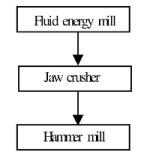
(B) 
(C) 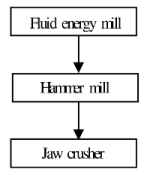
(D) 
Ans: (D)
18. Let i and j be the unit vectors in the x and y directions, respectively. For the function
F(x, y) = x3 + y2
the gradient of the function i.e.. ∇F is given by
(A) 3x2i – 2yj
(B) 6x2y
(C) 3x2i + 2yj
(D) 2yi – 3x2j
Ans: (C)
19. Consider steady state mass transfer of a solute A from a gas phase to a liquid phase. The gas phase bulk and interface mole fractions are yA, G and yA, i respectively. The liquid phase bulk and interface mole fractions are xA, L and xA, i, respectively. The ratio  is very close to zero.
is very close to zero.
The implies that mass transfer resistance is
(A) negligible in the gas phase only
(B) negligible in the liquid phase only
(C) negligible in both the phases
(D) considerable in both the phases
Ans: (B)
20. The value of ![]()
Ans: (1)
21. For a solid-catalyzed gas phase reversible reaction, which of the following statements is ALWAYS TRUE?
(A) Adsorption is rate-limiting
(B) Desorption is rate-limiting
(C) Solid catalyst does not affect equilibrium conversion
(D) Temperature does not affect equilibrium conversion
Ans: (C)
22. The one-dimensional unsteady heat conduction equation is

Where, T – temperature, t – time, r – radial position, k – thermal conductivity, ρ- density, and Cp – specific heat.
For the cylindrical coordinate system, the value of n in the above equation is
(A) 0
(B) 1
(C) 2
(D) 3
Ans: (B)
23. The composition of vapour entering a tray in a distillation column is 0.47. The average composition of the vapour leaving the tray is 0.53. The equilibrium composition of the vapour corresponding to the liquid leaving this tray is 0.52. All the compositions are expressed in mole fraction of the more volatile component.
The Murphree efficiency based on the vapour phase, rounded to the nearest integer, is ___ %.
Ans: (120)
24. The number of positive roots of the function f (x) shown below in the range 0 < x < 6 is ___________.
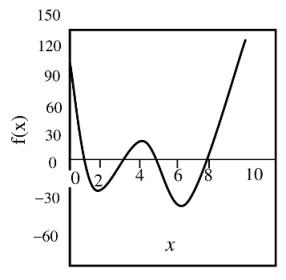
Ans: (3)
25. The following reaction rate curve is shown for a reaction A → P. Here, (−rA) and xA represent reaction rate and conversion, respectively. The feed is pure A and 90% conversion is desired

Which amongst the following reactor configurations gives the lowest total volume of the reactor (s)?
(A) CSTR followed by PFR
(B) Two CSTRs in series
(C) PFR followed by CSTR
(D) A single PFR
Ans: (A)
26. The total cost (CT) of an equipment in terms of the operation variable x and y is ![]()
The optimal value of CT, rounded to 1 decimal place, is _______.
Ans: (91.5)
27. The vapour pressure of a pure substance at a temperature T is 30bar. The actual and ideal gas values of g / RT for the saturated vapour at this temperature T and 30 bar are 7.0 and 7.7 respectively. Here, g is the molar Gibbs free energy and R is the universal gas constant. The fugacity of the saturated liquid at these conditions, rounded to 1 decimal place, is ___ bar.
Ans: (14.9)
28. The Sherwood number (ShL) correlation for laminar flow over a flat plate of length L is given by

Where ReL and Sc represent Reynolds number and Schmidt number, respectively.
This correlation, expressed in the form of Chilton-Colburn jD factor, is
(A) jD = 0.664
(B) ![]()
(C) jD = 0.664 ReL
(D) ![]()
Ans: (B)
29. For the initial value problem

the value of x at t = π/3, is _____.
Ans: (0.5)
30. In a counter current stripping operation using pure steam the mole ratio of a solute in the liquid stream is reduced from 0.25 to 0.05. The liquid feed flow rate, on a solute-free basis, is 3mole/s. The equilibrium line for the system is given in the figure below.

The MINIMUM flowrate of pure steam for this process, rounded to 1 decimal place, is ___mol/s.
Ans: (4)
31. The Laplace transform of a function is  The initial and final values, respectively, of the function are
The initial and final values, respectively, of the function are
(A) ![]()
(B) ![]()
(C) ![]()
(D) ![]()
Ans: (B)
32. The following table provides four sets of Fanning friction factor data, for different values of Reynolds number (Re) and roughness factor ![]()

Which of the above sets of friction factor data is correct?
(A) Set I
(B) Set II
(C) Set III
(D) Set IV
Ans: (C)
33. In a batch adsorption process, 5 g of fresh adsorbent is used to treat 1 litre of an aqueous phenol solution. The initial phenol concentration is 100 mg/litre. The equilibrium relation is given by q* = 1.3C
Where, q* is the amount of phenol adsorbed in mg of phenol per gram of adsorbent: and C is the concentration of phenol in mg/litre in the aqueous solution.
When equilibrium is attained between the adsorbent and the solution, the concentration of phenol in the solution, rounded to 1 decimal place is ___________ mg/litre.
Ans: (13.34)
34. A bond has a maturity value of 20,000 Rupees at the end of 4 years. The interest is compounded at the rate of 5% per year.
The initial investment to be made, rounded to the nearest integer, is _______ Rupees.
Ans: (16454)
35. Size analysis was carried out on a sample of gravel. The data for mass fraction (xi) and average particle diameter (Dpi) of the fraction is given in the table below :

The mass mean diameter of the sample, to the nearest integer, is ________mm.
Ans: (13)
36. A propeller (diameter D = 15 m) rotates at N = 1 revolution per second (rps). To understand the flow around the propeller, a lab-scale model is made. Important parameters to study the flow are velocity of the propeller tip (V = πND), diameter D and acceleration due to gravity (g). The lab-scale model is 1/100th of the size of the actual propeller.
The rotation speed of the lab-scale model, to the nearest integer, should be _________ rps.
Ans: (10.0)
37. The transfer function of a system is

For a unit step increase in the input, the fractional overshoot, rounded to 2 decimal places, is ______.
Ans: (0.37)
38. A fluid over a heated horizontal plate maintained at temperature Tw. The bulk temperature of the fluid is T∞ . The temperature profile in the thermal boundary layer is given by:

Here, y is the vertical distance from the plate, δt is the thickness of the thermal boundary layer and k is the thermal conductivity of the fluid.
The local heat transfer coefficient is given by
(A) ![]()
(B) ![]()
(C) ![]()
(D) ![]()
Ans: (C)
39. The following liquid second-order reaction is carried out in an isothermal CSTR at steady state A → R (−rA) = 0.005 CA2 mol/m3.hr
Where, CA is the concentration of the reactant in the CSTR. The reactor volume is 2m3, the inlet flow rate is 0.5 m3/hr and the inlet concentration of the reactant is 1000 mol/m3. The fractional conversion, rounded to 2 decimal places, is _____.
Ans: (0.80)
40. Reaction A → B is carried out in a reactor operating at steady state and 1 mol/s of pure A at 425℃ enters the reactor. The outlet stream leaves the reactor at 325℃. The heat input to the reactor is 17kW. The heat of reaction at the reference temperature of 25℃ is 30kJ/mol. The specific heat capacities (in kJ/mol.K) of A and B are 0.1 and 0.15, respectively.
The molar flowrate of B leaving the reactor, rounded to 2 decimal places, is ____mol/s.
Ans: (0.6)
41. The C-curve measured during a pulse tracer experiment is shown below. In the figure, C(t) is the concentration of the tracer measured at the reactor exit in mol/liter at time t seconds.
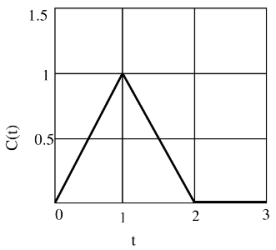
The mean residence time in the reactor, rounded to 1 decimal place, is ______ s.
Ans: (1.0)
42. The reversible reaction of t-butyl alcohol (TBA) and ethanol (EtOH) to ethylt-butyl ether (ETBE) is
TBA + EtOH ⇌ ETBE +Water
The equilibrium constant for this reaction is KC = 1. Initially, 74 g of TBA is mixed with 100g of aqueous solution containing 46 weight% ethanol. The molecular weights are:74g/mol for TBA. 46g/mol for EtOH, 102g/mol for ETBE, and 18 g/mol for water.
The mass of ETBE at equilibrium, rounded to 1 decimal place, is ____g.
Ans: (20.4)
43. Let Ibλ be the spectral black body radiation intensity per unit wavelength about the wavelength λ. The blackbody radiation intensity emitted by a blackbody over all wavelengths is
(A) ![]()
(B) ![]()
(C) ![]()
(D) ![]()
Ans: (C)
44. Match the equipment in Group-1 with the process in Group-2:
Group-1
(P) Fluidized bed
(Q) Multistage adiabatic reactor with Inter-stage cooling.
(R) Fourdrinier machine
(S) Diaphragm cell
Group-2
(I) Paper-making
(II) Sodium hydroxide manufacturer
(III) SO2 oxidation
(IV) Catalytic cracking
Choose the correct set of combinations.
(A) P − IV,Q − III,R − I,S − II
(B) P − IV,Q − III,R − II,S − I
(C) P − III,Q − IV,R − I,S − II
(D) P − III,Q − IV,R − II,S − I
Ans: (A)
45. Oil is being delivered at a steady state flowrate through a circular pipe of a radius 1.25 × 10−2 m and length 10 m. The pressure drop access the pipe is 500 Pa.
The shear stress at the pipe wall, rounded to 2 decimal places______ Pa
Ans: (0.3125)
46. Match the problem type in Group-1 with the numerical method in Group-2
Group-1 Group-2
(P) System of linear algebraic equations (I) Newton-Raphson
(Q) Non-linear algebraic equations (II) Gauss-seidel
(R) Ordinary differential equations (III) Simphson’s Rule
(S) Nemerical integrations (IV) Runge-Kutta
Choose the correct set of combinations.
(A) P − II,Q − I,R − III,S − IV
(B) P − I,Q − II,R − IV,S − III
(C) P − IV,Q − III,R − II,S − I
(D) P − II,Q − I,R − IV,S − III
Ans: (D)
47. The following gas-phase reaction is carried out in a constant-volume isothermal batch reactor
A + B → R + S
The reactants A and B as well as the product S are non-condensable gases. At the operating temperature, the saturation pressure of the product R is 40 kPa.
Initially, the batch reactor contains equimolar amounts of A and B (and no products) at a total pressure of 100 kPa. The initial concentrations of the reactants are CA, 0 = CB, 0 = 12.56 mol/m3. The rate of reaction is given by (−rA) = 0.08CACB mol/m3.s.
The time at which R just starts condensing, rounded to 1 decimal place, is_____
Ans: (4)
48. The vapor phase composition and relative volatilities (with respect to n-propane) on an ideal tray of a distillation column are

The mole fraction of n-propane in the liquid phase, rounded to 2 decimal places, is ____.
Ans: (0.88)
49. The Characteristic equation of a closed-loop system is
6s3 + 11s2 + 6s + (1 + k) = 0, Where k > 0
The value of K beyond which the system just becomes unstable, rounded to the nearest integer, is _____.
Ans: (10)
50. A aqueous salt-solution enters a crystallizer operating at steady state at 25℃. he feed temperature is 90℃ and the salt concentration in the feed is 40 weight%. The salt crystallizes as a pentahydrate. The crystals and the mother liquor leave the crystallizer. The molecular weight of the anhydrous salt is 135. The solubility of the salt at 25℃ is 20 weight%.
The feed flowrate required for a production rate of 100 kg/s of hydrated salt, rounded to the nearest integer, is ____ kg/s.
Ans: (200)
51. The pressure of a liquid is increased isothermally. The molar volume of the liquid decreases from 50.45 × 10−6 m3/mol to 48 × 10−6 m3/mol during this process. The isothermal compressibility of the liquid is 10−9 Pa−1, which can b e assumed to be independent of pressure.
The change in the molar Gibbs free energy of liquid, rounded to nearest integer, is J/mol.
Ans: (2511.4)
52. The open loop transfer function of a process with a proportional controller (gain KC) is 
Based on the Bode criterion for closed-loop stability, the ultimate gain of the controller, rounded to 2 decimal places, is____.
Ans: (0.78)
53. In nucleate boiling, the pressure inside a bubble is higher than the pressure of the surrounding liquid. Assuming that both the liquid and vapour are saturated, the temperature of the liquid will ALWAYS be
(A) at 100℃
(B) lower than the temperature of the vapour
(C) equal to the temperature of the vapour
(D) higher than the temperature of the vapour
Ans: (B)
54. A box has 6 red balls and white balls. A ball is picked at random and replaced in the box, after which a second ball is picked.
The probability of both the balls being red, rounded to 2 decimal places, is ____.
Ans: (0.36)
55. A sparingly soluble gas (solute) is in equilibrium with a solvent at 10 bar. The mole fraction of the solvent in the gas phase is 0.01. At the operating temperature and pressure, the fugacity coefficient of the solute in the gas phase and the Henry’s law constant are 0.92 and 1000 bar, respectively. Assume that the liquid phase obeys Henry’s law.
The MOLE PERCENTAGE of the solute in the liquid phase, rounded to 2 decimal places, is _____.
Ans: (0.91)
56. Consider the following sentences:
All benches are bed is a bulb. Some bulbs are lamps.
Which of the following can be inferred?
(i) Some beds are lamps.
(ii) Some lamps are beds.
(A) Only i
(B) Only ii
(C) Both i and ii
(D) Neither i nor ii
Ans: (D)
57. The following sequence of numbers is arranged in increasing order: 1,x,x,x, y, y,9,16,18. Given that the mean and median are equal, and are also equal to twice the mode, the value of y is
(A) 5
(B) 6
(C) 7
(D) 8
Ans: (D)
58. The bacteria in milk are destroyed when it _________ heated to 80 degree Celsius.
(A) would be
(B) will be
(C) is
(D) was
Ans: (C)
59. If the radius of a right circular cone is increased by 50%, its volume increases by
(A) 75%
(B) 100%
(C) 125%
(D) 237.5%
Ans: (C)
60. __________ with someone else’s email account is now very serious offence.
(A) Involving
(B) Assisting
(C) Tampering
(D) Incubating
Ans: (C)
61. Students applying for hostel rooms are allotted rooms in order of seniority. Students already staying in a room will move if they get a room in their preferred list. Preferences of lower ranked applicants are ignored during allocation.
Given the data below, which room will Ajit stay in?

(A) P
(B) Q
(C) R
(D) S
Ans: (B)
62. The bar graph below shows the output of five carpenters over one month, each of whom made different items of furniture: Chairs, tables, and beds.
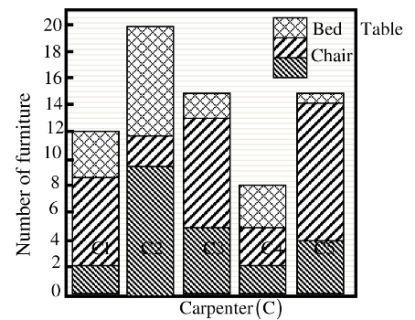
Consider the following statements.
(i) The number of beds made by carpenter C2 is exactly the same as the same as the number
of tables made by carpenter C3.
(ii) The total number of chairs made by all carpenters is less than the total number of tables.
Which one of the following is true?
(A) Only i
(B) Only ii
(C) Both i and ii
(D) Neither i nor ii
Ans: (C)
63. The last digit of (2171)7 + (2172)9 + (2173)11 + (2174)13 is
(A) 2
(B) 4
(C) 6
(D) 8
Ans: (B)
64. Two machines M1 and M2 are able to execute any of four jobs P, Q, R and S. The machines can perform one job on one object at a time. Jobs P, Q, R and S take 30 minutes, 20 minutes, 60 minutes and 15 minutes each respectively. There are 10 objects each requiring exactly 1 job. Job P is to be performed on 2 objects. Job Q on 3 objects. Job R on 1 object and Job S on 4 objects. What is the minimum time needed to complete all the jobs?
(A) 2 hours
(B) 2.5 hours
(C) 3 hours
(D) 3.5 hours
Ans: (A)
65. The old concert hall was demolished because of fears that the foundation would be affected by the construction tried to mitigate the impact of pressurized air pockets created by the excavation of large amounts of soil. But even with these safeguards, it was feared that the soil below the concert hall would not be stable.
From this, one can infer that
(A) The foundations of old buildings create pressurized air pockets underground, which are difficult to handle during metro construction.
(B) Metro construction has to be done carefully considering its impact on the foundations of existing buildings.
(C) Old buildings in an area form an impossible hurdle to metro construction in that area.
(D) Pressurized air can be used to excavate large amounts of soil from underground areas.
Ans: (B)
Latest Govt Job & Exam Updates: